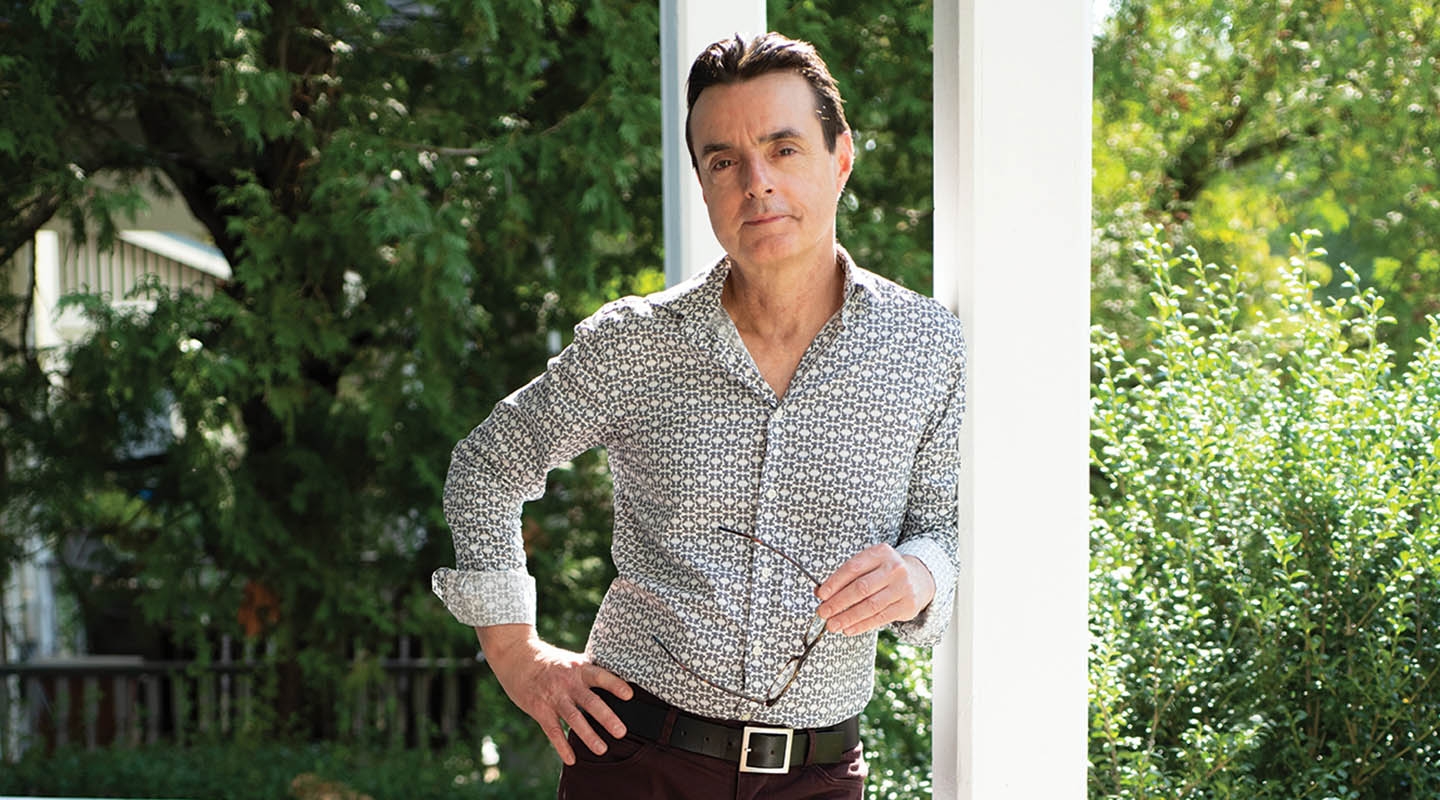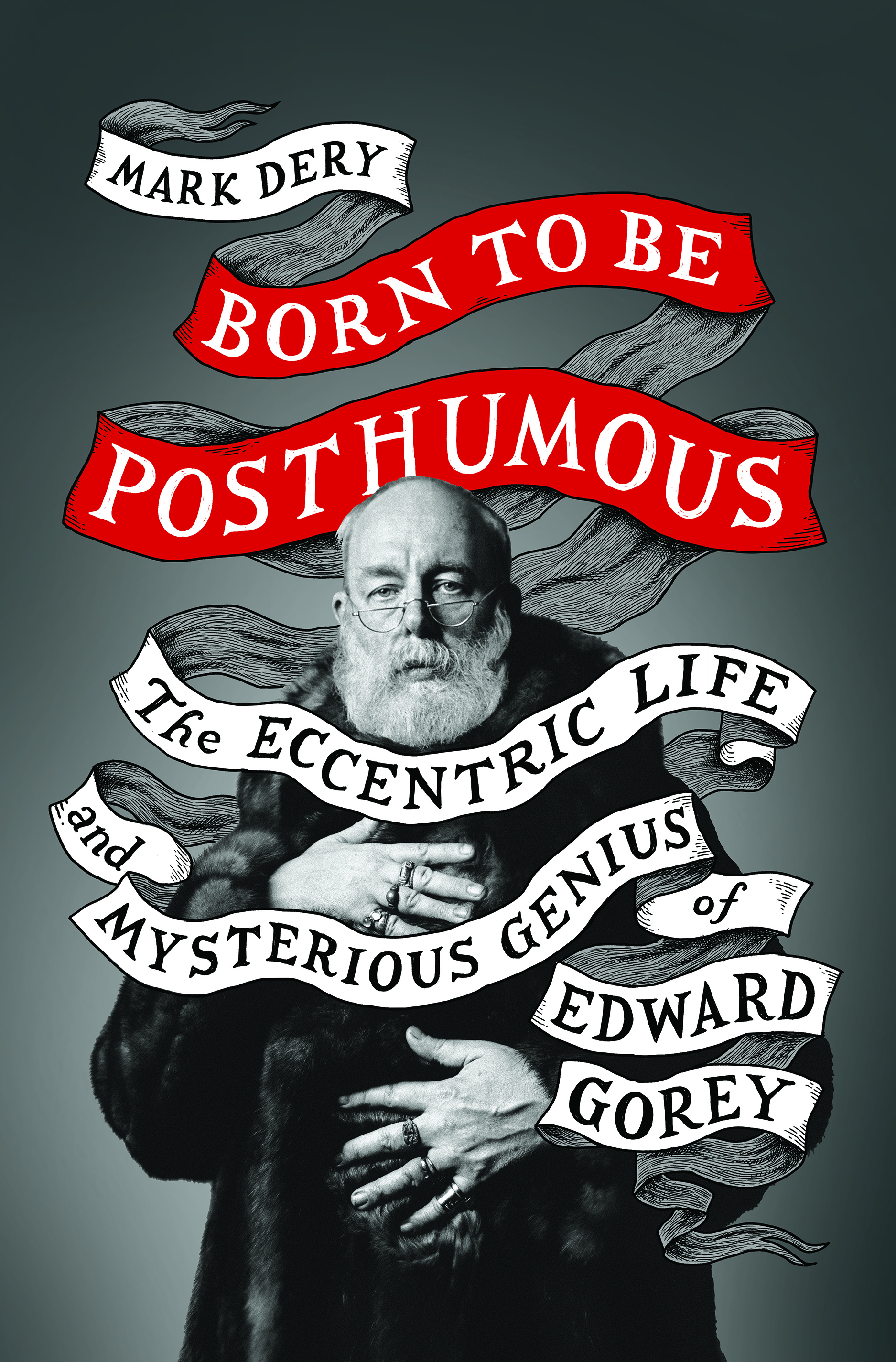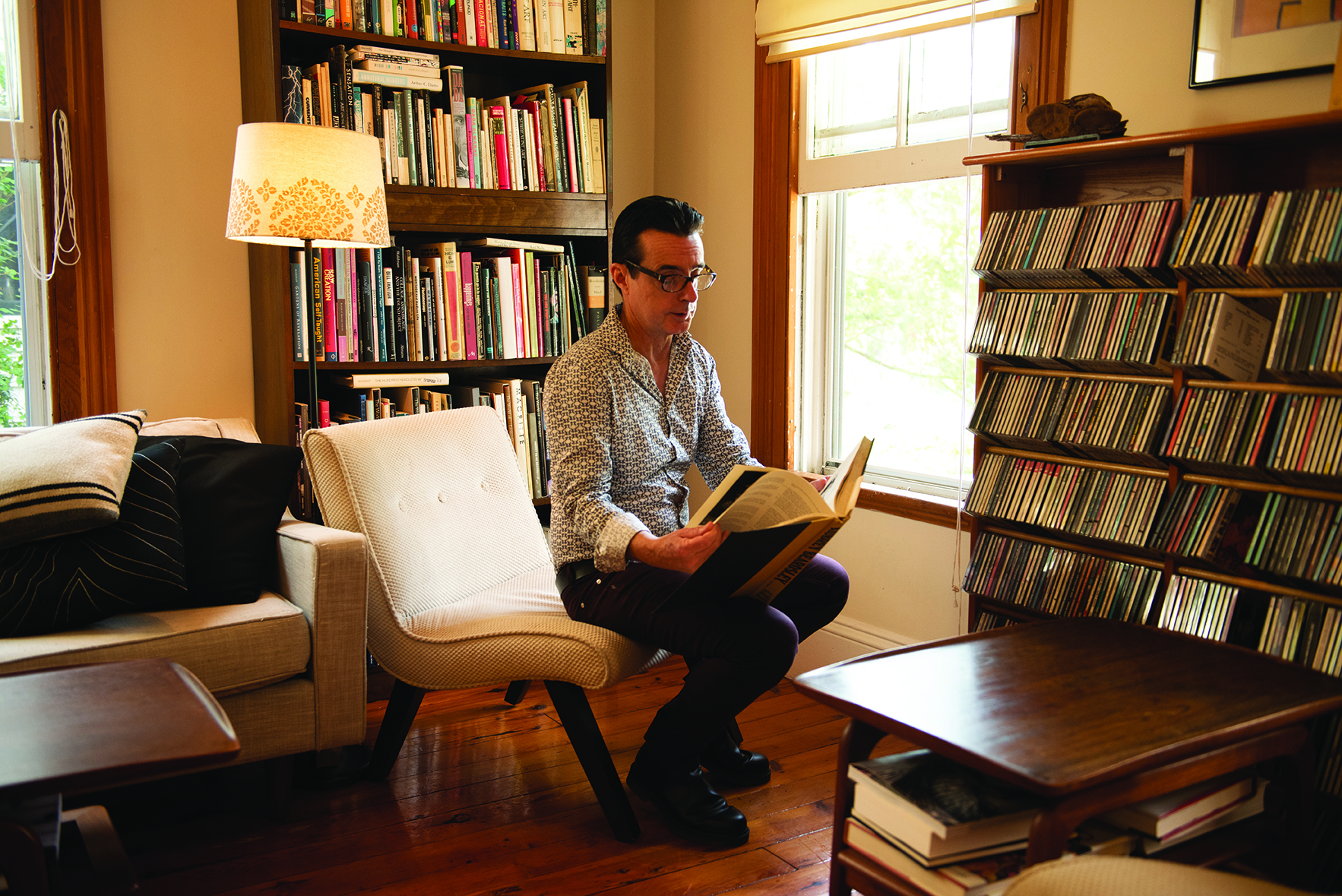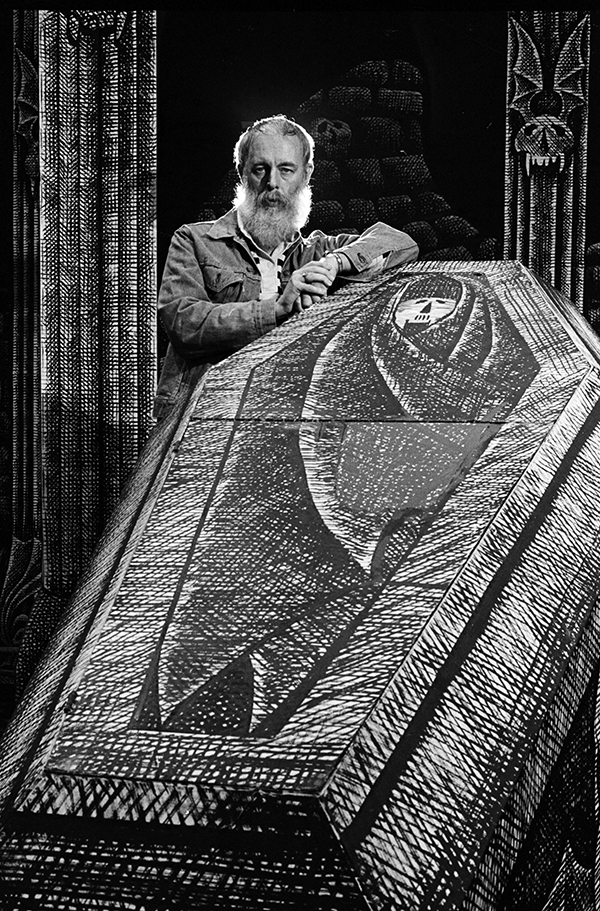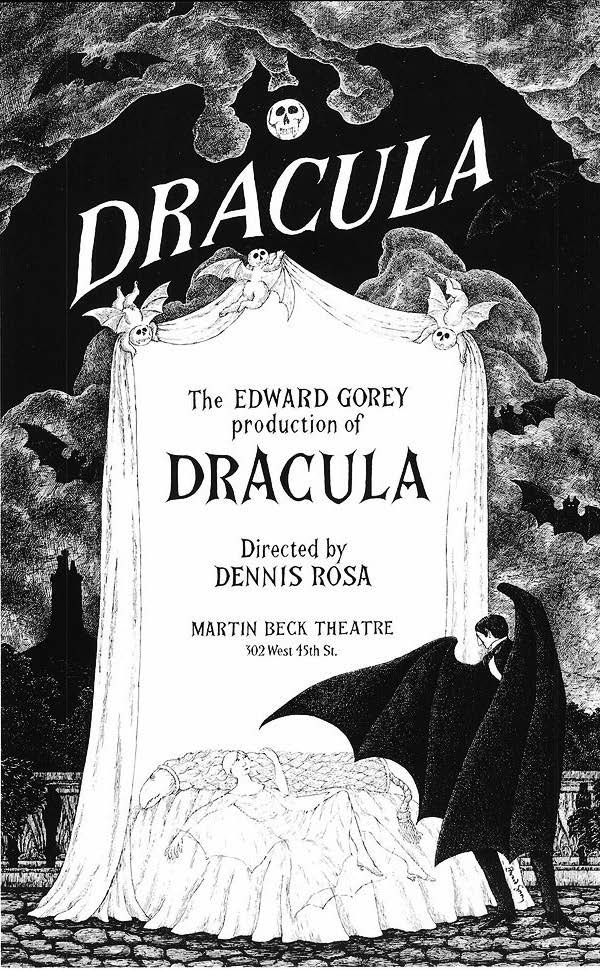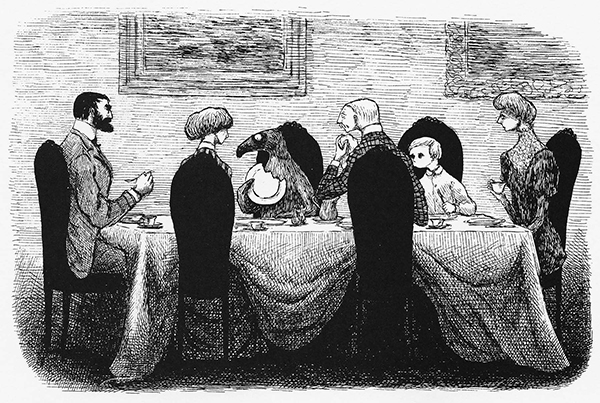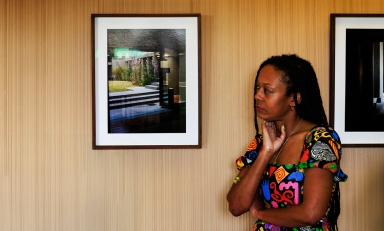Decades after a chance encounter in a bookstore with Edward Gorey, author Mark Dery ’82 digs deep into the life of the writer, illustrator, and incomparable eccentric
We live in a world where the opposite extremes of critique have been reduced to “awesome” and “sad,” whether the topic at hand is a burrito or a natural disaster.
This, however, is not the world that Mark Dery ’82 inhabits.
When Dery speaks or puts words on the page—plying his trade as lecturer, author, and cultural critic—it’s an immersive journey into his fecund mind, a trip that plumbs the depths of Merriam-Webster. The same applies to a simple phone conversation. The man is his work, and his work is quite a show.
“That’s who Mark is, he’s just an original,” says one of Dery’s oldest friends, fiction editor and writer Alexandra McNear ’84. “He’s incredibly articulate and intelligent and rigorous and thoughtful. I never met anyone who could talk the way he can. I don’t really know anyone else quite like that.”
Dery coined the term “Afrofuturism” (a cultural aesthetic revitalized by the success of Black Panther) in a 1993 essay titled “Black to the Future.” He introduced the phrase “culture jamming” (a guerrilla rebellion that appropriates advertising, imagery, and other talismans in a critique of commercial culture) to New York Times readers in a 1990 essay titled “The Merry Pranksters and the Art of the Hoax,” which he expanded into a 1993 monograph titled Culture Jamming: Hacking, Slashing, and Sniping in the Empire of Signs, published by Open Magazine in 1993.
The titles of Dery’s works are tantalizing invitations to his specialized dissections and dark revelations: Escape Velocity: Cyberculture at the End of the Century (1996), The Pyrotechnic Insanitarium: American Culture on the Brink(1999), and I Must Not Think Bad Thoughts: Drive-By Essays on American Dread (2012).
His latest effort is Born to be Posthumous: The Eccentric Life and Mysterious Genius of Edward Gorey. With a first printing of 30,000 and strong advance buzz in literary circles, it’s the first comprehensive biography of the late writer-illustrator, a grand and engrossing love letter to a unique talent. For Dery, it’s the culmination of seven years’ work, nearly 80 interviews, and a deep dive into all things Gorey—a distillation of Dery’s own formidable skills at this stage in his career.“By third grade I was convinced I was going to be the savior of American letters,” says Dery, who lives in Nyack, N.Y. His grandmother, a staunch Methodist, had been trained as a librarian “at the Moody Bible Institute, of all improbable places. And my mother had gone to Boston Art School, so it was almost foreordained that I would be an English major. I always excelled at the subject and loved it.”
Born in Braintree, Mass., Dery moved to Southern California at age 3 with his mother and stepfather, who was a machinist in the then-burgeoning aeronautics industry. The first landed in the town of Escondido and soon after moved to Chula Vista, a San Diego suburb just a few miles from the Mexican border.
“It was a very liminal spot like any border town,” says Dery, who spent his summers on nearby Imperial Beach “right by the border fence when it was in a state of dilapidation and no one took it seriously. It wasn’t the heavily fortified cordone sanitaire that it is now, but I used to lie there sunning myself and reading surrealist poetry, and you could run your fingers through the sands and find spent shell casings, presumably from the Border Patrol shooting at narcos or something.”
Though the New England native was something of a fish out of water on these shores, he was an observant fish who soaked up the terra firma world he found himself in. It was all formative stuff.
“It’s very odd being a Yankee and then moving to Southern California,” he says. “You almost can’t imagine a greater bipolarity. History lies much more heavily in New England. It’s haunted by the shades of Hawthorne and Emerson and Thoreau, and to my mind always had a very gothic quality. Everything is kind of this model railroader’s version of nature. The trees are small and everything’s scaled down and at the Cape the waves kind of nibble at your ankles.
“And then to have walked along the shores of Torrey Pines beach near La Jolla as a kid and see these gargantuan towering cliffs with sedimentary layer upon layer. I loved the notion that Jurassic oceans had rolled over what was now the desert. And to a card-carrying, practicing surrealist there’s nothing more surreal than the desert.”
In choosing a college, “a visionary teacher in high school pointed me toward Oxy, which was wonderfully generous and marvelously welcoming,” says Dery, who attended Occidental on scholarship. “The professors who bulked large in my mind were Dan Fineman, Eric Newhall, David James, and Martha Ronk. They were all extraordinary and exposed me to this notion that a text could have subtext. Who knew? Jungian symbolism and Freudian readings and Marxist readings and the whole arsenal of analytical tools that can be deployed by the literary critic. And that really kindled my interest in peeling the onion of literary interpretation.”
“Both Mark and I were aspiring poets, and so as a student he came to me for teacherly advice,” recalls James, now a professor of cinema and media studies at USC. “I was immediately struck by the galvanic nimbus around him that energized any situation he found himself in, making it more serious and more ambitious. Mark was then—and still is—a person who lives in language and for whom language is a sensual, indeed somatic, exercise.”But Dery, a guy who consumed the arts like a starving man at a casino buffet, didn’t confine his creative efforts to words on the page. He owned a Fender Telecaster guitar and knew how to play it.
“Toward the end of his time at Oxy he gave a performance of poetry and music somewhat like Patti Smith’s,” says James. “My only contribution was to advise him not to drink before it. Sensibly, he ignored me.”
Dery was a fan of the embryonic, snarling punk rock attitude as it emerged in the late ’70s, but “my sense of myself was forged by glam rock,” he says, “and very specifically David Bowie.” The late, multidiscipline icon has been the subject of more than a few Dery essays (most recently for theBrooklyn Rail).
Professor James’ poetry class introduced Dery to more than a just a few of the poets whom he counts among his favorites: Wallace Stevens, Charles Bukowski, and Emily Dickinson. It was there that he met Barack Obama ’83. Though the pair had a spontaneous debate on free-market capitalism while relaxing on the Quad one sunny day, “I was absolutely not an intimate of Obama’s,” emphasizes Dery. But he does have a story.
“A few of us had taken to straggling in, two, three, and then five, 10 minutes late. And James finally put his foot down. He said, ‘Henceforth, I’m laying down the law. If you’re not here by the time the bell rings, I’m locking the door and you’re not admitted.’”
Apparently the future president missed that class, and arrived to find the door, indeed, locked. “The next thing we know he’s wading through the hedges outside the window so he could get up to the glass and tap on it with this really forlorn look on his face,” Dery says. “And then he came around again to the door and I finally lost all patience.
“Budding punk rock anarchist that I was, I decided to make my great statement against tyrannical authority and I reached over and opened the door and let him in. James flashed me a vaguely disapproving look and Obama slunk in and tried to dissolve into his seat and disappear as quietly as possible.”
Occidental gave Dery more than just an education. He met his future wife on campus, author and lecturer Margot Mifflin ’82, who majored in English and was awarded a Watson Fellowship while at Oxy. Mifflin (who shared her own memories of Obama’s 1981 speech at a campus anti-apartheid rally in a 2012 article for The New Yorker) delivered the 2013 Charles Jensvold Memorial Lecture at Oxy titled “Art, Sex and Symbol: The Politics of Tattooed Women.” More recently, daughter Thea followed in her parents’ considerable footsteps, graduating from the College in 2017 as a Spanish studies major.
It all began with a freshman mixer in which Dery had absolutely zero interest. “In those days, the get-acquainted dance was a square dance,” he says. “The mortifying corniness of it made my flesh creep, so I was too cool to attend that, but a little while later they had a more civilized dance and I met Margot. She was spellbindingly beautiful, but we got talking and I realized that she was also blindingly brilliant and very interested in the arts. And so that’s really how we clicked.”
After graduating, Dery embarked upon his artistic journey, beginning with a move to the Bay Area. “In my infinite wisdom I had decided that performance poetry was a growth industry,” he says. “I spent a year working the circuit in San Francisco while working at a bookstore.”
In the decades to follow, Dery would go on to write acclaimed books and essays, teach media criticism at New York University from 2001 to 2010, become a Chancellor’s Distinguished Fellow at UC Irvine, and see his writing grace the pages of dozens of distinguished publications, from The Atlantic Monthlyand The Washington Post to Rolling Stoneand Wired. But when Dery arrived in New York City in 1983, “I kicked about from job to job as most Grub Street hacks do,” he says. “I did everything from waiting tables to various other jobs that will go unmentioned.”One that bears mention was his gig at Midtown Manhattan’s venerable Gotham Book Mart, a landmark shop frequented by a who’s who of literary bigwigs, among them Edward Gorey.
“My first exposure to Gorey, the man, was while working at the Gotham Book Mart. I heard this voice in fruity, flutey high tones declaiming around the store in this stentorian, impossibly campy style,” Dery says. “I looked up and saw this towering apparition in a floor-sweepingly long fur coat dyed Easter Peep yellow, this man with jangling bracelets, amulets and talismans and earrings, and this Victorian litterateur-like enormous white beard, and I thought, ‘Who is this preposterous creature?’”
Despite this definitive impression, Dery admits when it came to Gorey’s work, “I was never really bitten by the bug in those days.”
That would change.
Those not steeped in Gorey would likely know his work from the long-running PBS TV series “Mystery!”—his animated drawings serve as the show’s intro—or his Tony-nominated stage and costume designs for the hit 1977 Broadway production of Dracula, starring Frank Langella.
But Gorey, who died in 2000 at age 75, did much more than that. From 1953’s The Unstrung Harp to his final work in 1999, The Headless Bust, he published more than 100 books. His delicate pen-and-ink illustrations evoke a dark, Victorian-cum-Edwardian aesthetic, and perfectly complement his delightfully macabre writing where strange and gruesome things happen, often to children (though there are plenty of Gorey titles in the children’s section).
Dery—who grew to appreciate Gorey’s works post-Book Mart encounter—began reading Lemony Snicket’s writing to his young daughter, and was taken with the clear influence of Gorey. “I realized that it was more than just a camp Charles Addams, that some of the works really were profound, and I started delving much more deeply into them,” he says.
In 2000, novelist Alexander Theroux published The Strange Case of Edward Gorey, a slim volume about his longtime friend, “and I found it absolutely spellbinding,” Dery continues. “I started reading interviews with him, and everything I could get my hands on.”
In 2011, Dery was desperately searching for his next book topic, unable to settle on anything, when his wife suggested a biography of Gorey. Dery pitched it, and received a one-word reply from his agent: Sold.
“When he told me he was writing a book about Gorey, I didn’t bat an eye,” says Alexandra McNear. “I thought, of course. Gorey would be perfect for him to write about. The drawings are just totally Mark’s sense of the macabre.”
But creating a definitive bio on Gorey was no easy feat. He was every bit as mysterious and intriguing as his work, a flamboyant yet reclusive character who lived alone with cats, walls of books, and a mummified human head. Though his manner often was hot and cold running camp, he professed to being asexual. He was a person of contradictions.
“Gorey is grist for the biographer’s mill after all,” Dery writes in Born to Be Posthumous, “not only because he was an artist of uncommon gifts but because he was a world-class eccentric to boot.”“I wanted to reveal the man in full, seen from every possible angle simultaneously like the subject in a Cubist painting,” says Dery. “So just as I didn’t want to savor the unsavory, neither did I want to turn a blind eye on the facts of his inner life, to the extent that I could excavate them.”
In parsing the long-debated question of Gorey’s sexuality, he adds, “To have that eclipse the entire biography would really be myopic and vulgar. He was vastly more complex than that question, and such a rich and strange artist that I didn’t want to iris down the aperture to just peer through the keyhole of his bedroom. At the same time, I didn’t want to be coy and Victorian, putting pantalets on piano legs … but what I discovered early on is that one of the things that’s most delicious about Gorey is his mysteriousness.”
Dery’s passion for prose is no mystery, but what does it mean to him to be a writer, to engage in this ongoing, adventurous practice? “It’s partly just logophilia, the love of words, though saying ‘just’ dismisses the politics of style,” he replies. “Privileging language is a way of rejecting the tough-guy masculinity of Hemingway’s ‘muscular’ prose; of asserting the values of play and the irrational against the utilitarianism of Strunk and White.
“At the same time, writing isn’t just what I do, it’s who I am,” he continues. “I believe the self is a reflection in the mirror of language; without words—the inner monologue that narrates our thoughts—there is no ‘I.’”
Spoken like a born wordsmith.
Peter Gilstrap wrote “Economies of Scale” in the Summer issue. Dery photos by C. Taylor Crothers. Illustrations courtesy the Edward Gorey Estate. Gorey photo by Jack Mitchell/Getty Images.

